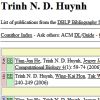|
|
|
|
|
|
|
|
| |
 
Jesper Jansson,
Konstantinos Mampentzidis,
Ramesh Rajaby and
Wing-Kin Sung. Computing the Rooted Triplet Distance Between Phylogenetic Networks. In IWOCA19, Vol. 11638:290-303 of LNCS, Springer, 2019.
Keywords: distance between networks, from network, phylogenetic network, phylogeny, polynomial, triplet distance.
|
|
|
|
|
|
| |
 
Jesper Jansson,
Ramesh Rajaby and
Wing-Kin Sung. An Efficient Algorithm for the Rooted Triplet Distance Between Galled Trees. In AlCoB17, Vol. 10252:115-126 of LNCS, Springer, 2017.
Keywords: distance between networks, from network, phylogenetic network, phylogeny, polynomial, reconstruction, triplet distance.
Note: .
|
|
|
|
|
|
| |
     
Hoa Vu,
Francis Chin,
Wing-Kai Hon,
Henry Leung,
Kunihiko Sadakane,
Wing-Kin Sung and
Siu-Ming Yiu. Reconstructing k-Reticulated Phylogenetic Network from a Set of Gene Trees. In ISBRA13, Vol. 7875:112-124 of LNCS, springer, 2013.
Keywords: from rooted trees, k-reticulated, phylogenetic network, phylogeny, polynomial, Program ARTNET, Program CMPT, reconstruction.
Note: http://grid.cs.gsu.edu/~xguo9/publications/2013_Cloud%20computing%20for%20de%20novo%20metagenomic%20sequence%20assembly.pdf#page=123.
Toggle abstract
"The time complexity of existing algorithms for reconstructing a level-x phylogenetic network increases exponentially in x. In this paper, we propose a new classification of phylogenetic networks called k-reticulated network. A k-reticulated network can model all level-k networks and some level-x networks with x > k. We design algorithms for reconstructing k-reticulated network (k = 1 or 2) with minimum number of hybrid nodes from a set of m binary trees, each with n leaves in O(mn 2) time. The implication is that some level-x networks with x > k can now be reconstructed in a faster way. We implemented our algorithm (ARTNET) and compared it with CMPT. We show that ARTNET outperforms CMPT in terms of running time and accuracy. We also consider the case when there does not exist a 2-reticulated network for the input trees. We present an algorithm computing a maximum subset of the species set so that a new set of subtrees can be combined into a 2-reticulated network. © 2013 Springer-Verlag."
|
|
|
|
|
|
| |
  
Reza Hassanzadeh,
Changiz Eslahchi and
Wing-Kin Sung. Constructing phylogenetic supernetworks based on simulated annealing. In MPE, Vol. 63(3):738-744, 2012.
Keywords: abstract network, from unrooted trees, heuristic, phylogenetic network, phylogeny, Program SNSA, reconstruction, simulated annealing, software, split network.
Note: http://dx.doi.org/10.1016/j.ympev.2012.02.009.
Toggle abstract
Different partial phylogenetic trees can be derived from different sources of evidence and different methods. One important problem is to summarize these partial phylogenetic trees using a supernetwork. We propose a novel simulated annealing based method called SNSA which uses an optimization function to produce a simple network that still retains a great deal of phylogenetic information. We report the performance of this new method on real and simulated datasets. © 2012 Elsevier Inc.
|
|
|
|
|
|
| |
  
Shlomo Moran,
Sagi Snir and
Wing-Kin Sung. Partial Convex Recolorings of Trees and Galled Networks: Tight Upper and Lower bounds. In ACM Transactions on Algorithms, Vol. 7(4), 2011.
Keywords: evaluation, galled tree, phylogenetic network.
Note: http://www.cs.technion.ac.il/~moran/r/PS/gnets-TOA-7Feb2007.pdf.
Toggle abstract
"A coloring of a graph is convex if the vertices that pertain to any color induce a connected subgraph; a partial coloring (which assigns colors to a subset of the vertices) is convex if it can be completed to a convex (total) coloring. Convex coloring has applications in fields such as phylogenetics, communication or transportation networks, etc. When a coloring of a graph is not convex, a natural question is how far it is from a convex one. This problem is denoted as convex recoloring (CR).While the initial works on CR defined and studied the problem on trees, recent efforts aim at either generalizing the underlying graphs or specializing the input colorings. In this work, we extend the underlying graph and the input coloring to partially colored galled networks. We show that although determining whether a coloring is convex on an arbitrary network is hard, it can be found efficiently on galled networks. We present a fixed parameter tractable algorithm that finds the recoloring distance of such a network whose running time is quadratic in the network size and exponential in that distance. This complexity is achieved by amortized analysis that uses a novel technique for contracting colored graphs that seems to be of independent interest. © 2011 ACM."
|
|
|
|
|
|
|
|
|
|
| |
  
Cam Thach Nguyen,
Nguyen Bao Nguyen and
Wing-Kin Sung. Fast Algorithms for computing the Tripartition-based Distance between Phylogenetic Networks. In JCO, Vol. 13(3), 2007.
Keywords: distance between networks, phylogenetic network, phylogeny, tripartition distance.
Note: http://dx.doi.org/10.1007/s10878-006-9025-5.
Toggle abstract
"Consider two phylogenetic networks N and N′ of size n. The tripartition-based distance finds the proportion of tripartitions which are not shared by N and N′. This distance is proposed by Moret et al. (2004) and is a generalization of Robinson-Foulds distance, which is orginally used to compare two phylogenetic trees. This paper gives an O(min {kn log n, n log n + hn} -time algorithm to compute this distance, where h is the number of hybrid nodes in N and N′ while k is the maximum number of hybrid nodes among all biconnected components in N and N′. Note that k ≪ h ≪ n in a phylogenetic network. In addition, we propose algorithms for comparing galled-trees, which are an important, biological meaningful special case of phylogenetic network. We give an O(n)-time algorithm for comparing two galled-trees. We also give an O(n + kh)-time algorithm for comparing a galled-tree with another general network, where h and k are the number of hybrid nodes in the latter network and its biggest biconnected component respectively. © Springer Science+Business Media, LLC 2007."
|
|
| |
   
Cam Thach Nguyen,
Nguyen Bao Nguyen,
Wing-Kin Sung and
Louxin Zhang. Reconstructing Recombination Network from Sequence Data: The Small Parsimony Problem. In TCBB, Vol. 4(3):394-402, 2007.
Keywords: explicit network, from sequences, labeling, NP complete, parsimony, phylogenetic network, phylogeny.
Note: http://www.cs.washington.edu/homes/ncthach/Papers/TCBB2007.pdf.
|
|
|
|
|
|
| |
  
Jesper Jansson,
Nguyen Bao Nguyen and
Wing-Kin Sung. Algorithms for Combining Rooted Triplets into a Galled Phylogenetic Network. In SICOMP, Vol. 35(5):1098-1121, 2006.
Keywords: approximation, explicit network, from triplets, galled tree, phylogenetic network, phylogeny, polynomial, reconstruction.
Note: http://www.df.lth.se/~jj/Publications/triplets_to_gn7_SICOMP2006.pdf.
Toggle abstract
"This paper considers the problem of determining whether a given set Τ of rooted triplets can be merged without conflicts into a galled phylogenetic network and, if so, constructing such a network. When the input Τ is dense, we solve the problem in O(|Τ|) time, which is optimal since the size of the input is Θ(|Τ|). In comparison, the previously fastest algorithm for this problem runs in O(|Τ|2) time. We also develop an optimal O(|Τ|)-time algorithm for enumerating all simple phylogenetic networks leaf-labeled by L that are consistent with Τ, where L is the set of leaf labels in Τ, which is used by our main algorithm. Next, we prove that the problem becomes NP-hard if extended to nondense inputs, even for the special case of simple phylogenetic networks. We also show that for every positive integer n, there exists some set Τ of rooted triplets on n leaves such that any galled network can be consistent with at most 0.4883 ·|Τ| of the rooted triplets in Τ. On the other hand, we provide a polynomial-time approximation algorithm that always outputs a galled network consistent with at least a factor of 5/12 (> 0.4166) of the rooted triplets in Τ. © 2006 Society for Industrial and Applied Mathematics."
|
|
| |
 
Jesper Jansson and
Wing-Kin Sung. Inferring a level-1 phylogenetic network from a dense set of rooted triplets. In TCS, Vol. 363(1):60-68, 2006.
Keywords: explicit network, from triplets, galled tree, level k phylogenetic network, phylogenetic network, phylogeny, polynomial, reconstruction.
Note: http://www.df.lth.se/~jj/Publications/ipnrt8_TCS2006.pdf.
Toggle abstract
"We consider the following problem: Given a set T of rooted triplets with leaf set L, determine whether there exists a phylogenetic network consistent with T, and if so, construct one. We show that if no restrictions are placed on the hybrid nodes in the solution, the problem is trivially solved in polynomial time by a simple sorting network-based construction. For the more interesting (and biologically more motivated) case where the solution is required to be a level-1 phylogenetic network, we present an algorithm solving the problem in O (| T |2) time when T is dense, i.e., when T contains at least one rooted triplet for each cardinality three subset of L. We also give an O (| T |5 / 3)-time algorithm for finding the set of all phylogenetic networks having a single hybrid node attached to exactly one leaf (and having no other hybrid nodes) that are consistent with a given dense set of rooted triplets. © 2006 Elsevier B.V. All rights reserved."
|
|
| |
   
Ying-Jun He,
Trinh N. D. Huynh,
Jesper Jansson and
Wing-Kin Sung. Inferring Phylogenetic Relationships Avoiding Forbidden Rooted Triplets. In JBCB, Vol. 4(1):59-74, 2006.
Note: http://www.df.lth.se/~jj/Publications/forb_triplets7_JBCB2006.pdf.
Toggle abstract
"To construct a phylogenetic tree or phylogenetic network for describing the evolutionary history of a set of species is a well-studied problem in computational biology. One previously proposed method to infer a phylogenetic tree/network for a large set of species is by merging a collection of known smaller phylogenetic trees on overlapping sets of species so that no (or as little as possible) branching information is lost. However, little work has been done so far on inferring a phylogenetic tree/network from a specified set of trees when in addition, certain evolutionary relationships among the species are known to be highly unlikely. In this paper, we consider the problem of constructing a phylogenetic tree/network which is consistent with all of the rooted triplets in a given set C and none of the rooted triplets in another given set F. Although NP-hard in the general case, we provide some efficient exact and approximation algorithms for a number of biologically meaningful variants of the problem. © Imperial College Press."
|
|
|
|
|
|
| |
   
Charles Choy,
Jesper Jansson,
Kunihiko Sadakane and
Wing-Kin Sung. Computing the maximum agreement of phylogenetic networks. In TCS, Vol. 335(1):93-107, 2005.
Keywords: dynamic programming, FPT, level k phylogenetic network, MASN, NP complete, phylogenetic network, phylogeny.
Note: http://www.df.lth.se/~jj/Publications/masn8_TCS2005.pdf.
Toggle abstract
"We introduce the maximum agreement phylogenetic subnetwork problem (MASN) for finding branching structure shared by a set of phylogenetic networks. We prove that the problem is NP-hard even if restricted to three phylogenetic networks and give an O(n2)-time algorithm for the special case of two level-1 phylogenetic networks, where n is the number of leaves in the input networks and where N is called a level-f phylogenetic network if every biconnected component in the underlying undirected graph induces a subgraph of N containing at most f nodes with indegree 2. We also show how to extend our technique to yield a polynomial-time algorithm for any two level-f phylogenetic networks N1,N2 satisfying f=O(logn); more precisely, its running time is O(|V(N1)|·|V(N2)|·2f1+f2), where V(Ni) and fi denote the set of nodes in Ni and the level of Ni, respectively, for i∈{1,2}. © 2005 Elsevier B.V. All rights reserved."
|
|
| |
  
Jesper Jansson,
Nguyen Bao Nguyen and
Wing-Kin Sung. Algorithms for Combining Rooted Triplets into a Galled Phylogenetic Network. In SODA05, Pages 349-358, 2005.
Keywords: approximation, explicit network, from triplets, galled tree, phylogenetic network, phylogeny, polynomial, reconstruction.
Note: http://portal.acm.org/citation.cfm?id=1070481.
|
|
| |
|
| |
   
Trinh N. D. Huynh,
Jesper Jansson,
Nguyen Bao Nguyen and
Wing-Kin Sung. Constructing a Smallest Refining Galled Phylogenetic Network. In RECOMB05, Vol. 3500:265-280 of LNCS, springer, 2005.
Keywords: from rooted trees, galled tree, NP complete, phylogenetic network, phylogeny, polynomial, Program SPNet, reconstruction.
Note: http://www.df.lth.se/~jj/Publications/refining_gn3_RECOMB2005.pdf.
|
|
| |
|
| |
|
|
|
|
|
| |
   
Charles Choy,
Jesper Jansson,
Kunihiko Sadakane and
Wing-Kin Sung. Computing the maximum agreement of phylogenetic networks. In Proceedings of Computing: the Tenth Australasian Theory Symposium (CATS'04), Vol. 91:134-147 of Electronic Notes in Theoretical Computer Science, 2004.
Keywords: dynamic programming, FPT, level k phylogenetic network, MASN, NP complete, phylogenetic network, phylogeny.
Note: http://www.df.lth.se/~jj/Publications/masn6_CATS2004.pdf.
Toggle abstract
"We introduce the maximum agreement phylogenetic subnetwork problem (MASN) of finding a branching structure shared by a set of phylogenetic networks. We prove that the problem is NP-hard even if restricted to three phylogenetic networks and give an O(n2)-time algorithm for the special case of two level-1 phylogenetic networks, where n is the number of leaves in the input networks and where N is called a level-f phylogenetic network if every biconnected component in the underlying undirected graph contains at most f nodes having indegree 2 in N. Our algorithm can be extended to yield a polynomial-time algorithm for two level-f phylogenetic networks N 1,N2 for any f which is upper-bounded by a constant; more precisely, its running time is O(|V(N1)|·|V(N 2)|·4f), where V(Ni) denotes the set of nodes of Ni. © 2004 Published by Elsevier B.V."
|
|
| |
 
Jesper Jansson and
Wing-Kin Sung. Inferring a level-1 phylogenetic network from a dense set of rooted triplets. In COCOON04, Vol. 3106:462-471 of LNCS, springer, 2004.
Keywords: explicit network, from triplets, galled tree, level k phylogenetic network, phylogenetic network, phylogeny, polynomial, reconstruction.
Note: http://www.df.lth.se/~jj/Publications/ipnrt6_COCOON2004.pdf.
|
|
|
|
 - forked on GitHub.
- forked on GitHub.















